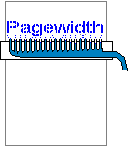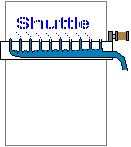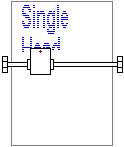| Inkjet Printheads Printers > Inkjet > Printheads | Navigation Icons Guide
|
Ink has a long history. Inkjets have very little history, the technique used in drop-on-demand printers was almost unknown until the 1970s and only became commonplace in the 1990s.
There are two broad types of inkjet head.
| Drop on demand - ink drops are pulsed out of chambers when an electric current flows. Drop on demand printheads are usually made by ceramic forming and silicon chip photolithographic processes. The printhead is a key to defining the printers characteristics - its purchase and operating cost, print speed and quality. |
In an inkjet head there need be no moving parts except liquid ink. The chemistry of a coloured ink may be fairly complex but once it is determined the material is cheap to make and not too difficult to handle and store.
There are only four companies making heads in large volume - Canon, HP, Lexmark and Epson. The primary market for these heads is the domestic and commercial computer user, so mass production at low cost is the aim.
There are also some industrial head makers such as Xaar, Spectra, Ricoh and Konica. The target market is broader - ranging from screen print to medical microdosing and micromanufacturing. However industrial heads currently sell in small quantities so they are comparatively expensive.
Principle of Drop on Demand. 
Several principles are used in inkjet designs:- Tubes hold liquid ink and a heat-element that makes steam-bubbles to eject ink.
- Epson uses a piezo-electric element to eject ink from the elements.
- Samsung has a patent on electromagnetically actuated ball bearings.
- Phase-change devices turn a solid ink to liquid or vapour near the moment of use.
| Ink chamber full | Heater on, bubble forms | Ink droplet driven out | Heater off, bubble collapses | Droplet in page. Ink chamber refilled |
The ink mainly blows out of the nozzle on firing because the reservoir is massive by comparison with the print element. In fact some ink does blow back creating hydraulic cross-talk but baffles and slots dissipate the energy.
The ink doesn't simply drop out of the nozzles because they are tiny so it is held by surface tension - and because the air supply behind is restricted.
The problem is to refine this into something that can be relied on in practical office conditions. The manufacture of an inkjet head is an act of mass market micro- engineering.
Thermal. 
Most inkjet heads use a thermal mechanism. The force driving the ink is made by bubbles formed by water vapour from a heater evaporating the ink carrier. The current to the heater pulses on and off rapidly. The head itself might be glass, silicon, ceramic, or even largely plastic with heaters in the form of resistors embedded in the walls of capillary tubes. Electrical connections to the drive logic control each heater. The head also has to carry plumbing connecting each tube to the ink reservoir, commonly a cartridge above the head.From the point of view of print quality and speed the smaller and more numerous the chambers and nozzles the better - providing they can be assembled reliably and at low cost in a factory, then deliver a cost-effective field life.
Heaters in the chambers are thin-film resistors. There is some overlap in manufacturing techniques used for flat thermal transfer heads (of the kind used in faxes and labelling machines) and the more complicated forms used in thermal inkjet.
Heater material is usually a tantalum aluminium alloy. This is deposited on a glass, ceramic or most likely silicon substrate - the material will be chosen to keep manufacturing as simple and straight forward as possible. The resistors are interconnected with aluminium traces then a protective or barrier layer of silicon nitride or silicon carbide formed on top. Older printheads with few heaters simply had connectors to the carriage and back to the control board. Newer printheads with hundreds of heaters have local drive transistors or a whole control chip - sometimes referred to as the "intimate electronics". The electronics need some cover from the ink. this is provided by a barrier layer.
Thermal cycling is an issue. The thin-film resistors are subjected to rather extreme thermal cycling - the sudden temperature rises and falls as the ink in the chamber superheats, vaporizes and refills. The intensity of the thermal cycling is unusual - there aren't many applications where a material changes temperature over several hundred degrees centigrade at intervals as short as a tenth of a microsecond. (The actual temperature for the superheated steam bubble may be about 300 Centigrade). The explosive environment in a car engine is more violent but it isn't on a microscopic scale. Cavitation forces as the vapour bubble collapses may be powerful, attempting to pull the thin film resistor material off the chamber wall. Delamination of materials is one cause of failure.
Ink chemistry needs to match the job. Early inkjet developers thought ordinary ink might be adequate, but then they observed a phenomenon called "kogation" - formation of a scale on top of the heater resistors. The shape was apparently reminiscent of Japanese "Kogu" biscuits, hence the name.
Kogation separates ink from resistor causing ink ejection to be irregular and the resistor material to overheat and burn out. Ink materials need to be pure with no salts or acids to prevent kogation.
Inks also attack the adhesives used to glue the cartridge elements together, and any exposed electronics - like the surfaces of the resistor heaters. Trace metals and a non-neutral pH may have an impact on metal components and electronics.
Thermal heads seem to need a low viscosity aqueous ink chemistry so it is not as flexible as the piezoelectric alternative which can handle a wider range of liquids.
Types. 
Thermal printheads are divided into two types depending on how the heater elements are aligned with the print nozzles:
| Roof-shooters place the heater element immediately under the nozzle - this is the technique favoured by HP and Lexmark. |  |
The roof-shooter thermal element is symmetrical and centralized under its nozzle layer. The spacing can be quite close, with ink rushing in from the side to replace droplets. The close spacing allows short droplet flight time, a high firing frequency and good placement of droplets on the paper.
Another advantage of the roof-shooter is that ink from the reservoir behind can be used to cool the chip.
Ensuring the nozzle layer is correctly aligned is reputedly a problem.
| Edge-shooters place the heater in a wall of the nozzle - this configuration has been favoured by Canon and Xerox. | 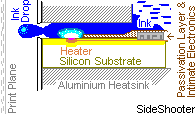 |
The edge shooter builds its heaters down the chip then aligns a channelled assembly on top. The heaters are a bit further from the nozzle because otherwise the effect would be a sputtering of ink sideways rather than shooting a droplet at the page. The ink moves to the side of the heater. Replacement ink rushes in from behind. The longer separation between element and nozzle may imply a lower firing frequency and / or less accurate drop placement.
Assembling the edge shooter is reputedly easier than a roof shooter, so costs may be lower.
Manufacturers. 
Canon, HP and Lexmark are the main producers of thermal heads - they license technology to a few others. Thermal heads are commonly said to be fairly cheap to make - although since the assemblies are complex cheap is clearly a relative term for something that needs a cross between a semiconductor and a plumbing job in a rather special factory.
A lot of the effort in head design is to make printheads using just a few commonplace component forming techniques but to still get the right fluid dynamics to provide an ink dot that can be precisely and rapidly placed.
Contributory technologies include - semiconductor chip making for the electronics, nickel electroforming for the nozzle plate, plastic or ceramic mouldings for ceiling plates. Ideally the nozzle plate is faced with a coating of unwettable material so that ink cannot build up there.
The market for mass-manufactured thermal printheads is huge - just about every office and half the homes in most industrialised countries. The market is just about limitless because given the right price printers can be used in faxes, cameras and childrens toys. But there are currently only four or five players with the muscle to esablish a factory and put worldwide distribution in place.
| Inkjet cartridge manufacturers might well get a market lead by boasting bigger, longer lasting, lower cost cartridges. Certainly in the last few years the costs of cartridges have been an issue, with newspaper headlines screaming they are the "most expensive liquid in the world". Despite manufacturers best efforts thermal heads suffer from reliability problems. Ultimately kogation, cavitation, electrolysis or a fatal blockage will get one or more nozzles and then the head is done-for. |
Manufacturers might be expected to match the ink content of a cartridge to the anticipated head life.
Theoretically it might be possible to have a user-dismantleable, repairable head, but
| The process would be very messy for users - the whole purpose of ink is that it is intended to stain paper permanently -so it doesn't make an exception for hands and carpets. |
| Fast, cheap assembly implies just a few machine assembled glued parts with no leaks or lines of weakness - not something easy to take apart. |
A common technique is to incorporate thermal heads into a fairly small cartridge of ink and dispose of them when it is exhausted.
Obviously it is possible to refill disposable cartridges on the assumption that the printheads will have some further usable life - if they do well and good. If not, hard luck.
Refill ink is readily available, sometimes even with little syringe kits and instructions for the cartridge.
Refilling doesn't necessarily match the interests of the big manufacturers - after all if cartridge life were doubled sales would be halved. On the other hand being able to demonstrate a conclusive cost advantage would benefit public attitude and market share.
Some inkjet heads use a piezoelectric mechanism. A crystal of an appropriate material such as the ceramic PZT changes shape when an electric current passes, then returns to shape when it ceases. The piezoelectric effect is not so dramatic as the thermal effect, the change in dimension is about 1% and is typically on the submicron scale.
| To get a large ink movement with piezo actuation the head designer might make the crystal work a diaphragm forming one wall of a chamber that is large by comparison with the ink orifice. The small movement of the diaphragm becomes a large pressure at the orifice, sufficient to overcome viscosity and surface tension. | 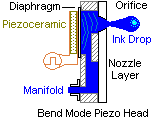 |
Piezo elements can also be stacked so that multiple small actions build into something more significant
Forming a significant piezoelectric crystal within or near a microscopic chamber means the heads are complicated and more expensive to make. However piezoelectric heads are less stressed by operation, so they tend to be more reliable. The design intention with a piezoelectric or "PIJ" head is that they should last the lifetime of the printer.
Epson is the major manufacturer shipping liquid piezo heads in the consumer market. Epson makes its heads part of the carriage, but usually as replaceable spare. Epson heads as spares are unfortunately so costly that it is not always worth the labour and parts cost of repairing an Epson printer.
The main problem with PIJ heads seems to be air bubbles. If the printer ever runs out of ink then the printhead develops an air bubble in a few channels and this can prove extraordinarily difficult to shift. This is presumably because the drive chamber is relatively large and the movement of the piezoceramic is small. Air is compressible, so the diaphragm with an air bubble in its chamber flaps around uselessly and can't re-establish its pumping action. Epson always leaves some ink in cartridges to avoid air locks happening. It is possible to use a chip-resetter to force an Epson cartridge to run on, the only problem being that if an air bubble does get in it may need an entire cartridge used on cleaning cycles in an attempt to flush out an air bubble.
The need to avoid air bubbles also means a special kind of ink. The ink should have no dissolved air and might be vacuum packed into its cartridge so that it doesn't foam. Cartridges should be swapped straight away so that ink has no chance to evaporate.
| Xerox Phasers are the other mass market piezoelectric device. Phaser ink is very different - molten wax at 135 centigrade. This demonstrates one of the benefits of the piezo head, the technique can handle more or less anything. Where a thermal head elies on making a gas bubble to expel ink the piezo head doesn't have to do this- it is just a pump, it doesn't react with the ink. |  |
Xerox bought the Tektronix division making solid-ink "Phaser" printers. Tektronix patented a method for allowing air bubbles to escape, presumably this passed to Xerox.
Industrial inkjet heads are usually piezoelectric - these are the kind of heads used for printing posters or personalising runs in a print works.
Manufacturers of industrial PIJ heads tend to make them from photochemical etched stainless steel plates. The plates are stacked, then bonded or brazed at high temperature to make a complex assembly with the interconnecting manifolds for ink flow and chambers for the piezoelectric elements.
It would be possible to make a rather nice printhead that could be dismantled, cleaned and reassembled.
Because individual PIJ elements are very reliable heads can contain thousands of them. Xerox colour heads contain a couple of thousand elements and are nevertheless expected to last a "lifetime". (Manufacturers love the term lifetime).
The piezoelectric effect could in principle operate very rapidly. The crystal timebases used in computer circuits vibrate on a small scale millions of times per second - up to 50MHz before reliability becomes and issue. Obviously the crystals in PIJ heads are bigger and might be expected to be slower. Mechanical effects like cavitation should be less important because there is nothing to de-laminate within the head but there will be an upper limit to frequency.
New Scientist reports that Samsung has a patent (GB 2 330 799) Samsung proposes using tiny ball bearings actuated by an electromagnets. The ink would be stored in a cavity behind a fine nozzle and backed by a silicone rubber membrane. (New Scientist 26th June 1999)
A practical inkjet head is a compromise between print quality, speed, reliability, ease of manufacture and ease of use.
As manufacturing technology improves so can the number of nozzles in a head. The extra nozzles can be used to make the head faster, produce higher print quality or both.
The print swath is the stripe of print across the page that the printhead can create at one go.
If the printer is to be fast then the more individual print-elements there are the better.
With a large print head that has lots of elements printing can be quicker
With a small printhead with lots of elements printing can be at higher resolution.
Printhead width or "swath" as it is sometimes called is a problem of manufacturing and field-service reliability. This same problem limits dot matrix and thermal machines.
Thermal direct and transfer printers can use wide print-heads because the device is simple. The head is a bar of ceramic with embedded heaters so it is possible to make a head with 2,400 elements or more (300 dots per inch, 8 inch print width). Thermal inkjet and thermal transfer heads have similarities but the inkjets need for chambers and ink supply plumbing mean it is more complicated to make.
Inkjet heads are usually thermal devices, but with the addition of the plumbing for the ink, making them far more complicated to manufacture. Manufacturers are thought to be investigating the possibility of heads with thousands of elements, but none have come to the mass market as yet. The problem seems to be the relatively high probability that a channel in the head will block and prove impossible to purge.
In an industrial head for a printworks this kind of thing is surmountable, the head can be swapped out, dismantled and cleaned. In a device for office or home use the mess and potential for error is probably too great.
If page-width inkjet heads can be produced for office printers then the printers will be able to match or exceed the performance of the fastest laser printers. The simpler process of an inkjet make it likely that the cost per page could be lower than a laser could achieve.
The need for multiple elements can be understood in terms of speed, quality or both.
Actual print-heads are a compromise between the ideal of a page width head with 2,400 (or probably many more chambers to handle greyscale) and the fact that the probability of failure increases with each element added.
Timings for thermal printheads given by Hue P. Le are that bubble formation and collapse take 10us but then ink refill can take 80 to 200 us.
The firing rate might conceivably rise much higher to the 150kHz of continuous feed inkjet nozzles if the ink could be pressure fed - but that might prove messy and there are other problems with stresses like cavitation that are likely to limit a thermal head.
Cavitation is a problem with thermal heads. The chamber is alternately heating and pressurising ink, then condensing the vapour and sucking more in. The heater elements tend to be a thin film on the wall so the changes in pressure and the rush of liquid are acting on this film like a wallpaper stripper.
Print Elements. 
The original Siemens PT80 and later HP ThinkJet had just 12 print elements - a number that seems to have been chosen to make them slightly more attractive than 9 pin dot matrix printers.
| The number of elements in a head today differs between printers but is generally between 50 and 500 elements per head. Given the lower number of elements and a resolution of 300dpi older inkjet printers achieve speeds of 1 to 4 pages per minute. The swath allows two or three lines of text to be printed at one go. | 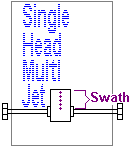 |
More recent printers with both more elements and a larger swath have both higher resolution and higher speed. Some printers claim speeds beyond 20 ppm. Speeds like this are likely to depend on how much RAM and processor power the driving computer can dedicate to the job. Most inkjets rely on their driver, they don't have an independent RIP.
Manufacturers have recently increased the number of elements in their head designs to give higher resolutions. Epson’s latest machines are capable of around 5,000 dpi. The aim of this is not so much to give fine lines but a better colour gamut by having more pixels making up any perceived area.
| An inkjet head usually contains some electronics for the heaters or piezo-electric elements. A simple 12-element head might just need 13 external connections so this isn't too difficult to achieve with nothing more than a connector. Most consumer inkjet heads have many more elements - hundreds. Even if a head only contains 50 elements this implies more that 50 power-carrying connections to the control circuitry - 50 element connectors and several common bus-bars to form the circuits. |  |
| Large numbers of connections always create problems. A thermal head cartridge generally has a small flexible circuit board bonded to it carrying printed wires to connector pads that mate with the carriage. Manufacturers mount the head chip on the flexible wiring. This will need to be done quickly if it involved solder because the flexible boards are not very resilient. Any great number of interconnections that can easily fail. | 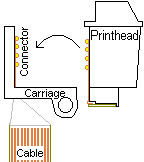 |
Rather than try to put increasing numbers of connections on a head manufacturers opt to use a drive matrix. A 50 element head could use a 7 x 8 connection grid for the same effect, however that is still 15 connections.
The print-head itself is usually based on a ceramic or silicon chip, so building some circuitry onto it is natural - this forms an "integrated driver printhead".
Integrating driver circuitry into a printhead suggests problems. For instance ink ingredients such as water and anionic dispersants might change the characteristics of transistors. The circuitry has to be insensitive to ink. On the other hand the pulses of energy to the firing chambers are brief but powerful, ink may help keep the circuitry cool. Fewer connections give more reliability, at the cost that manufacturing transistors on the head silicon makes it more complicated.
Integrated circuitry can be taken further. A shift-register and latches can be integrated onto the print-head chip to allow data to be loaded serially. This head-mounted deserialiser and driver circuit controls the individual elements. Nevertheless there are often a couple of dozen connections to the head – often made by small gold-plated springy plastic pads.
Airlocks might not only block the flow of ink temporarily but allow ink to dry locally deep inside the head so that it is difficult to flush out. One possibility is that an airlock next to a heater element would allow localised overheating, causing an element in the head to fail.
A more serious problem is likely to be blockages or outright failure of an element. Any contaminant in the ink, such as sediment or foreign matter introduced by fitting a cartridge onto an old head could block one of the capillary tubes. In an attempt to avoid this, the manufacturers use ink filtered to sub-micron particle sizes, and print-heads integrated with a sealed ink tank are widely used.
One improvement that inkjet makers rather like and users are more sceptical about is the idea of incorporating a small memory into a head. The memory can tell the printer its date of manufacture and its work cycle - so that the printer can cut out and demand another head if it that supplied might be unsatisfactory. User concern is obviously that manufacturers want to stamp out recycling.
At present there are tools that will re-write data to such printheads.
Printhead Life.
One problem with increasing the number of print elements is print-head life; this may be threatened by wear, tube blockages, kogation, airlocks and electrical failure.
When the printer is out of use the ends of the capillaries will dry out. Most printers make some provision to shield the head from the atmosphere when it is not in use. Recent printers usually park the head over a silicon rubber cup which is part of an assembly that might be called the "service station". If it is to do this the printer must be allowed to follow a power-down sequence and not just turned off at the wall. Older printers often had a stainless steel shutter spring loaded to close into position. The exact formulation of the ink - for instance the balance between water and isopropyl alcohol, will have an effect on the drying time – the ideal ink would dry immediately on contact with paper, but not at all in air. Electo-rheological fluids don't seem to have been tried - yet.
Wear. 
Inkjet printheads shouldn't strictly contact the paper, and only moves liquid ink. On the other hand something shooting picolitre drops accurately needs to get pretty close so it will contact in places.
The head does usually contact the service station. Most service stations seem to use a soft rubber pad to polish the head. Even a hard ceramic material will gradually wear away as it passes across paper, and if the dimensions of the inkjet tubes change then the accuracy of the ink delivery will decline.
Reliability Issues. 
If there is one point against inkjet printers as a consumer and office item it is their reliability - or rather lack of it. Technicians get tired of advising users to run the cleaning cycle or replace the cartridge. Anyone in IT management gets suspicious of the waste of cartridges. Some designs are worse than others but few inkjets give four or five years of trouble free service.
Reliability problems in inkjet heads can be addressed in several ways.
Disposable heads are one approach. Hewlett Packard makes the head on most recent low end printers a part of the inkjet cartridge. This inevitably means that the cartridges are rather expensive to buy - on the recent printers about £16 for mono and £22 for a tricolour cartridge. Printheads may not actually be defective when they are thrown away. A compensation is that a new cartridge will almost always clear a fault.
Canon has tried several approaches. The BJ200 has an integrated head and ink cartridge- although if this is prized apart it is actually made of a head and a reservoir. The BJC600 uses separate cartridges closely coupled with the head on the carriage. Cartridges are a regular but low cost consumable, the head needs replacement less often. The BJC800 has large cartridges in the base connecting to the head by pipes.
These printers are all using thermal printheads
Epson printheads use a piezo-electric effect to fire ink at the page. The piezo head is fairly reliable - but inclined to develop a permanent airlock if the ink ever runs out.
No one approach seems to entirely overcome reliability problems. From time to time cartridges have to be wasted with the ink only part used.
--
© Graham Huskinson 2010
This page is like all those in the "book" section in being under development.
If you think this page is wrong in some respect or have better information on how things are done let us know. Click here.



